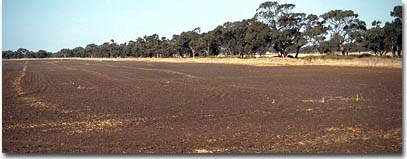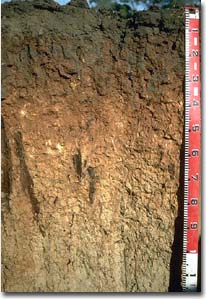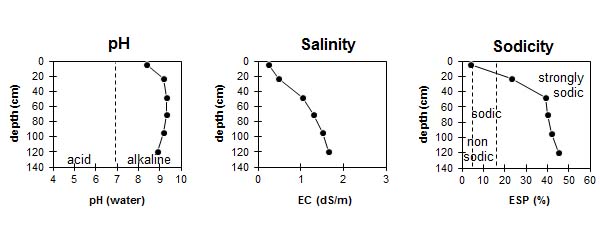LS13
Location: Netherby
Australian Soil Classification: Epicalcareous-Epihypersodic, Self-mulching, Brown VERTOSOL
Northcote Factual Key: Ug 5.3
Great Soil Group: brown clay
General Landscape Description: Gently undulating plain with Brown and Grey Vertosols. This site is in a slightly higher position, near the base of a rise.
 LS13 Landscape |
Soil Profile Morphology:
Surface Soil
| A1 | 0-10 cm | Dark brown (7.5YR3/2); light medium clay; moderate coarse blocky structure; weak consistence moist; pH 8.4: |  LS13 Profile |
| Subsoil | |||
| B21 | 10-35 cm | Strong brown (7.5YR4/6); heavy clay; strong coarse prismatic, parting to coarse blocky structure; pH 9.2: | |
| B22k | 35-60 cm | Yellowish red (5YR5/6); medium heavy clay; firm consistence moist; contains few (5%) soft and hard calcium carbonate in pockets; pH 9.3: | |
| B23 | 60-80 cm | Very pale brown (10YR7/4); medium clay; pH 9.3: | |
| B24 | 80-110 cm | Pale brown (10YR6/3); medium clay; strong lenticular structure; firm consistence moist; pH 9.2: | |
| B25 | 110+ cm | Light grey (2.5Y7/2); medium clay; strong lenticular structure; pH 8.9. | |
Key Profile Features:
- High clay content throughout the profile.
- Self-mulching and friable nature of surface soil.
- Significant cracking occurs when dry. Cracks usually appear at the surface.
- Strong vertic properties (as evident by lenticular structure and slickensides).
Soil Profile Characteristics:
| - | pH | Salinity | ||
Surface (A1 horizon) | Moderately Alkaline | Very Low | Non-Sodic | Slaking, No Dispersion1 |
Subsoil (B21 horizon) | Very Strongly Alkaline | Low-Medium | Strongly Sodic | Strong |
Deeper Subsoil (at 1 metre) | Very Strongly Alkaline | Very High | Strongly Sodic | Strong |

| The surface soil is moderately alkaline. The subsoil is very strongly alkaline throughout. | The salinity rating is very low in the surface. The subsoil is low becoming very high with depth. | The surface is non-sodic. The subsoil is strongly sodic. |
Chemical and Physical Analysis:
Horizon | Horizon Depth (cm) | pH (water) | pH (CaCl2) | EC dS/m | Sodium Chloride % | Exchangeable Cations | |||
Ca | Mg | K | Na | ||||||
meq/100g | |||||||||
A1 | 0-10 | 8.4 | 7.7 | 0.25 | 16.5 | 4 | 1.9 | 0.9 | |
B21 | 10-35 | 9.2 | 8.3 | 0.49 | 13 | 10 | 1.3 | 7.1 | |
B22 | 35-60 | 9.3 | 8.6 | 1.05 | 0.15 | 6.7 | 9.7 | 1.2 | 10.9 |
B23 | 60-80 | 9.3 | 8.7 | 1.31 | 0.2 | 6.3 | 9.7 | 1.3 | 11.5 |
B24 | 80-110 | 9.2 | 8.6 | 1.52 | 0.26 | 7.2 | 11.5 | 1.3 | 14 |
B25 | 110+ | 8.9 | 8.4 | 1.65 | 0.29 | 6.2 | 11.5 | 1.3 | 15.2 |
Horizon | Horizon Depth (cm) | Total Nitrogen % | Oxidisable Organic Carbon % | Field Capacity pF2.5 | Wilting Point pF4.2 |
A1 | 0-10 | 0.12 | 1.8 | 30.1 | 18.7 |
B21 | 10-35 | 48.1 | 31.2 | ||
B22 | 35-60 | 43.5 | 27.4 | ||
B23 | 60-80 | ||||
B24 | 80-110 | ||||
B25 | 110+ |
Management Considerations:
Surface (A) Horizon
- The clayey surface horizons have a relatively high wilting point indicating that plants will not be able to fully utilise light rains falling on relatively dry soil.
- The surface soil has a high inherent fertility (based on the sum of the exchangeable basic cations).
- Tillage or excessive trafficking of clay soils should be avoided if the soil is moist to wet (ie. wetter than the plastic limit). At such moisture conditions, tillage or excessive trafficking can result in structural damage (eg. compaction, smearing) occurring. Ideally, tillage should take place when the soil is drier than the plastic limit, down to at least the tillage depth.
- The strongly sodic and dispersive subsoil is likely to restrict water and root movement.
- An increase in soluble salt levels in the deeper subsoil may restrict the growth of salt sensitive species.
- The very strongly alkaline subsoil indicates that certain nutrients (eg. iron, manganese, copper and zinc) may be poorly available to plants.
Comments from Landholder:
- Nitrogen and superphosphate applied.
- Continuously cropped with grains (wheat, barley and oats) and legumes (peas, chickpeas and vetch).
- Land in production since the early 1940's.
- Direct drilling used as the cultivation method.
- Gypsum not used.


